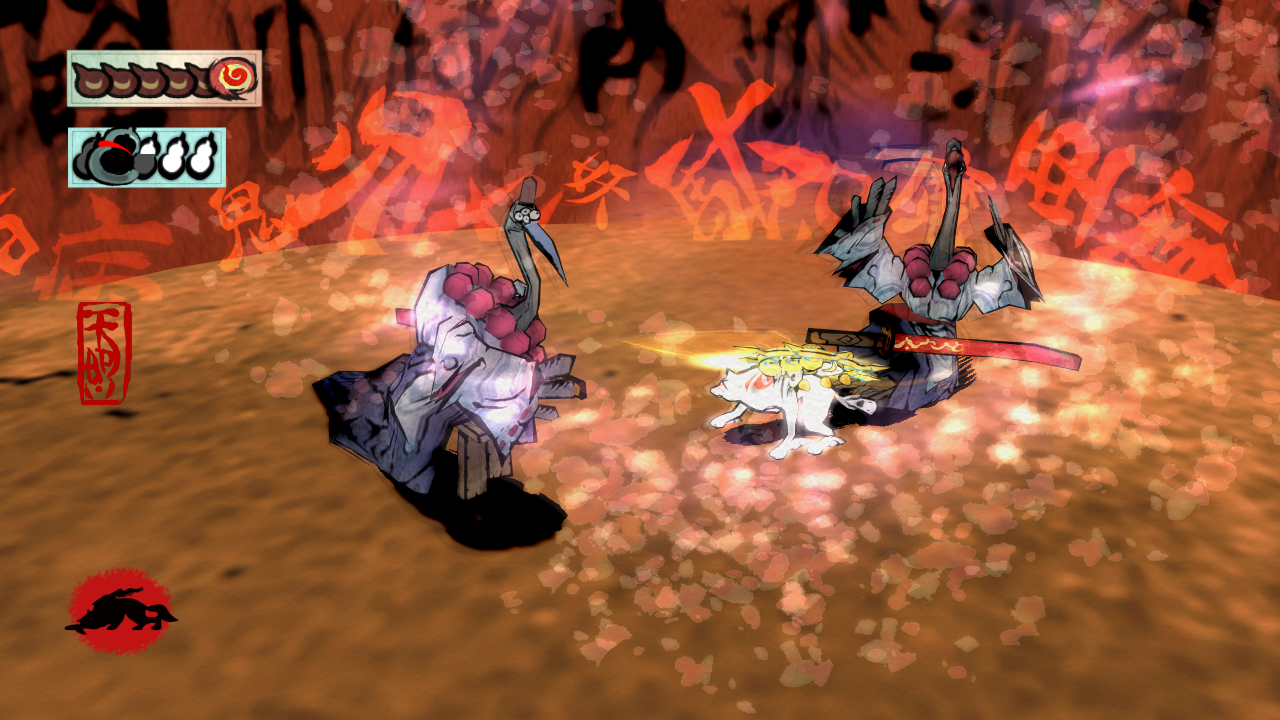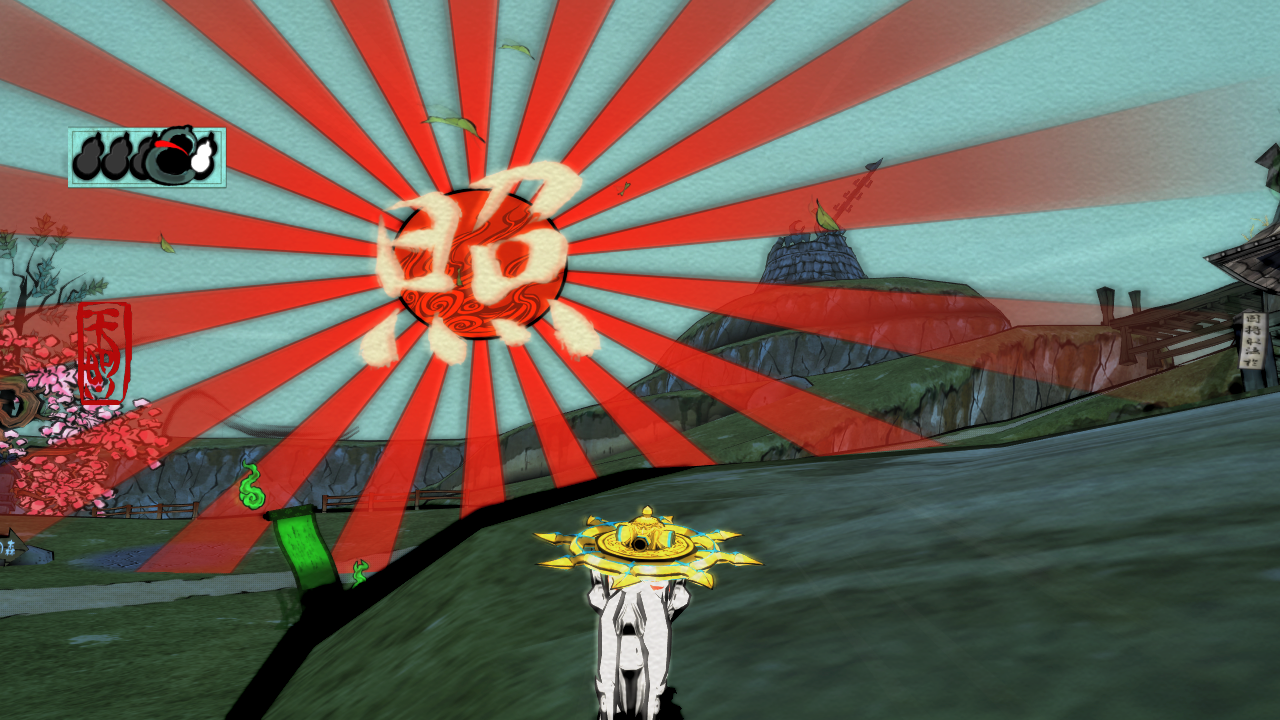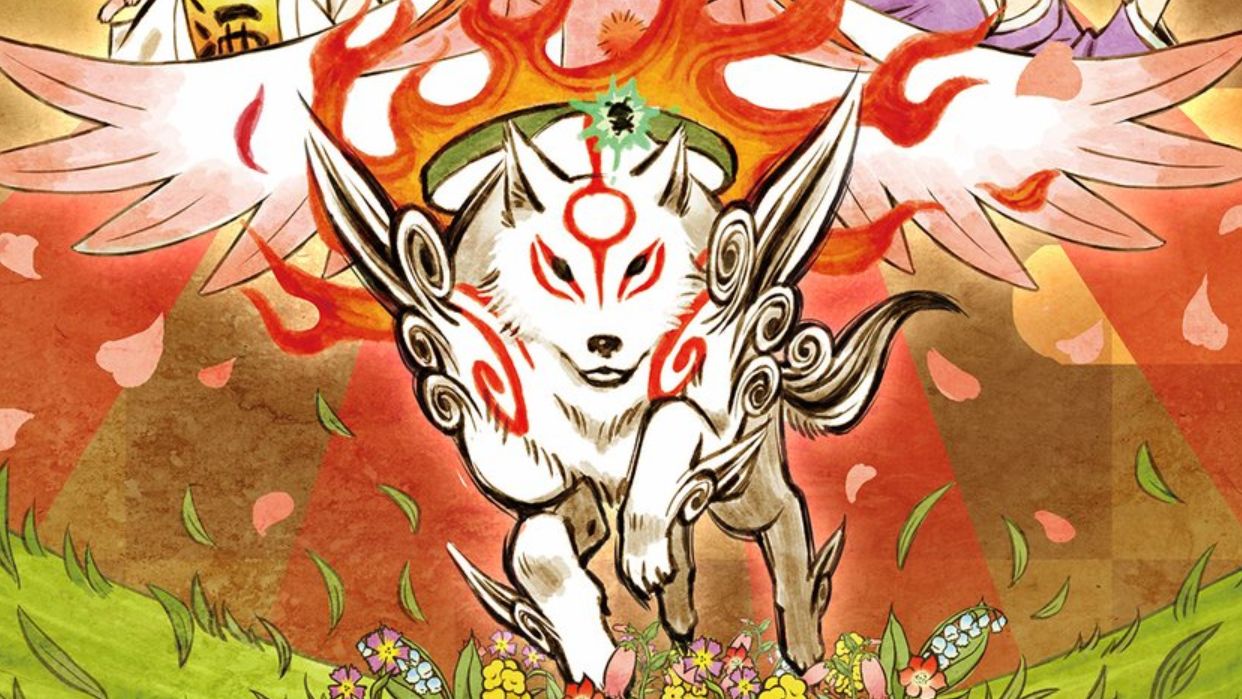Our Verdict
Occasionally languid to the point of lethargy, Okami is a gorgeous and unforgettable adventure all the same.
PC Gamer's got your back
What is it? A long, leisurely action-adventure starring a wolf with godly powers.
Expect to pay: $20/£16
Reviewed on: Intel Core i5-4440, 8GB RAM, GeForce GTX 645
Developer: Clover Studio/Hexadrive
Publisher: Capcom
Multiplayer: No
Link: Official site
Yes, you can skip the intro. If you’ve played Okami before, you’ll know it’s a slow starter—and even if you haven’t, you may well have heard as much. Essentially, it’s 15 minutes or so of blissfully unhurried scene-setting, literally unfurling across a paper scroll that seems to stretch on forever. Yet the languid storytelling is a patience test in a very real sense: if you can sit through it without fidgeting too much, then you’re perfectly qualified for the sweeping, serenely-paced saga that follows.
At the risk of invoking Alan Partridge, Okami is a deep bath of a game, an adventure to sink into and luxuriate in. It’s not a game you can play in bite-sized pieces, but rather one to clear long evenings and weekends for, to stock up on snacks and drinks and settle down with for the duration. It’s arguably indulgent to a fault: you’ll probably be ready for it to be over comfortably before it actually ends, but in a way that’s in keeping with the game’s generosity of spirit: if in the end it gives you a bit too much, surely that’s better than not enough?
And goodness, it’s still beautiful. The HD treatment means it looks a little crisper than the soft-focus original, but it mostly serves as a reminder that gorgeous, distinctive art design will always outlast attempts at photorealism. This folkloric vision of Nippon is a world of thick, inky lines and great washes of colour. At first, however, they’re murky and muted: the land has been blighted by the return of an ancient demon, and, as a white wolf inspirited by the sun goddess Amaterasu, you’re asked to sort things out and restore Nippon to its former glory.

The results of your efforts are so joyous you’ll want to clear up every last bit of malingering evil. With the help of a divine brush, you can physically paint over the bad stuff: bold strokes and swirls of ink produce cascades of cherry blossoms and rushing waves of blooms that race across the ground like an unstoppable wave, the camera struggling to keep pace as tainted territory suddenly flourishes with new life.
On PC, Okami feels similarly refreshed, with mouse controls proving a perfect fit for Amaterasu’s Celestial Brush.
On PC, Okami feels similarly refreshed, with mouse controls proving a perfect fit for Amaterasu’s Celestial Brush. Stretch your pinky down to the Ctrl key and you’ll pull up a piece of parchment; click the left button to press the bristles against it and then you can easily sweep it across or around, or in graceful loops. (Or, if you’re me, an awkward, lumpy approximation of a loop—the kind that would cause Sonic the Hedgehog a serious injury were he to attempt to speed around it.) It can be fussy when it comes to recognising your daubings, actually: it’s doubly annoying when your insect-sized ally, Issun, chides you when you’ve done the right thing, but not quite precisely enough for the game’s liking. But it’s forgiving enough that mistakes are rarely costly. Using WASD for movement is an acceptable trade-off; there’s controller support here, but drawing doesn’t feel nearly as intuitive with a pad.
The real benefits come during combat, where the immediacy of the brush controls means you can call upon its deific powers much more often. An ink meter ensures you can’t just use it for every attack, but it’s more fun to mix things up anyway. With two of a steadily growing range of celestial weapons bound to each mouse button, you can whip enemies with a close-range melee attack to send them sprawling, before following up with a volley of fire from range and then pulling out the brush to cleave them in two as a final flourish.
If you’re more of an explorer than a fighter, don’t worry: combat is rarely a roadblock, and many encounters are optional. Sure, some opponents require specific techniques to defeat: one beast requires you to wear it down before it collapses, ready for its protective shell to be opened up with your Bloom ability so you can happily whale on its weak point. But plenty of others will eventually yield to relatively crude tactics if you’re more of a button-masher. Then again, scrapping with style is incentivised, with a ranking for each encounter – from a wilting sapling to a sakura tree in full blossom – determining your post-battle cash reward and encouraging you to finish quickly without taking damage.

Okami’s a technically competent port without many bells and whistles. It runs at a locked 30fps, which suits the game but will no doubt disappoint some—I expect modders will already be working on changing this. Beyond that, it does the basics, offering a range of resolutions (up to 4K on capable hardware) and the ability to enable V-sync, but not much besides. You can choose between the original 4:3 aspect ratio and a widescreen presentation, and while load times are short, there’s an option to enable the loading screen minigames that weren’t included in earlier ports.
Some brush abilities do feel slightly overpowered. Conjure a large cherry bomb next to just about any opponent and you’re laughing, but the sheer breadth of abilities makes you more likely to experiment: drawing dots to produce a wall of thin trees gives you a breather in the tougher battles. Pulling up a menu to use health top-ups or consumables that convey temporary buffs feels like a clunky throwback, but if you’re careful enough you’ll rarely need to use these. And during the sporadic boss fights, you might welcome the brief reprieve while you heal up or shuffle your attacking options.
These encounters are expertly staged, with creative touches that make the monstrous, imposing guardians so much more than just a longer health bar to slowly whittle down. One can be hooked onto hovering blossoms to hold it in place, while a multi-headed behemoth requires you to pour sake down its necks to get it sleepily drunk. With clear tells, incoming attacks can be dodged without too much effort, while weapons that double as shields give you extra protection in a pinch. With a dodge and a leap that allow you to avoid blows with room to spare, they’re as forgiving as Hideki Kamiya-directed boss fights are ever likely to get: some might take a while, but the outcome is never really in doubt. Still, it’s only right that you should feel powerful, even in the face of an opponent the size of a pagoda; you are, after all, blessed with the power of a god.
The ease of combat—and the ability to sprint away from encounters in the overworld—encourages you to spend more time exploring all corners of Nippon. And away from the critical path, there’s plenty to find, with dozens of rustic vignettes that expertly blend light and dark: these are places haunted by ghosts of the past (and unsettled by a clear and very present danger) but the villagers and townsfolk you meet are frequently funny and memorable.
There’s plenty of to-ing and fro-ing should you choose to tackle those side quests, and though Amaterasu moves at a fair clip when she reaches full speed—an odd but charming touch requires her to gradually build momentum—the segmented nature of the world makes backtracking less enjoyable. There is a fast-travel system, though in keeping with Okami’s desire to let everything unfold at a measured pace, it discourages you from using it too often by making you pay for the privilege. You’ll have to stump up the yen for a special coin, which can be dropped into a body of water to create a vortex, letting you warp to similar points across Nippon.

If it’s rare to encounter a game that follows the rituals and routines of Japanese myth, Okami also follows some more conventional rhythms. In a structural sense it’s similar to a Zelda game—or at least a Zelda game prior to Breath of the Wild—with a large, open hub linking smaller, more labyrinthine areas, many of which yield new abilities that in turn unlock more of the world.
Okami’s dungeons aren’t as intricate as its closest inspiration, and its puzzle solutions are often alarmingly simple, though often the joy is in the details: the tactile process of drawing water from a pool to fill sake barrel, for example, or a lift mechanism that sucks up bombs, the explosion sending you rocketing up to the next floor. There are silly and exciting set pieces besides: you might have to dig through rocks to find a water source against the clock, or prevent a log from plunging down a waterfall by tethering it to flowers on the riverbank as it hurtles along. It’s a little more flexible than old-school Zelda in places, and by the latter stages you’ll have enough powers that there’s often more than one way to deal with a situation. If a treasure chest is protected by licking flames and there are no pools nearby, you can produce a swirl of wind to blow them out instead.
Not to get too soppy about it, but there’s something in the way Okami directly involves you in the telling of its story—essentially casting you as an artist retelling a fable in the strokes of your brushwork—that feels strangely magical. There’s a sense of wonder in even the simplest interactions, whether it’s gentle dabs of ink producing stars to complete constellations, a crescent to accelerate nightfall, or a snaking line traced to a floating bloom to spirit Amaterasu upward. It’s there, too, in its quieter moments, like the idyllic animation that plays out when you feed a wild animal, the camera lazily circling as they chow down while Amaterasu peacefully sits and watches. Like the intro, you can skip it. But why would you want to?
Occasionally languid to the point of lethargy, Okami is a gorgeous and unforgettable adventure all the same.


